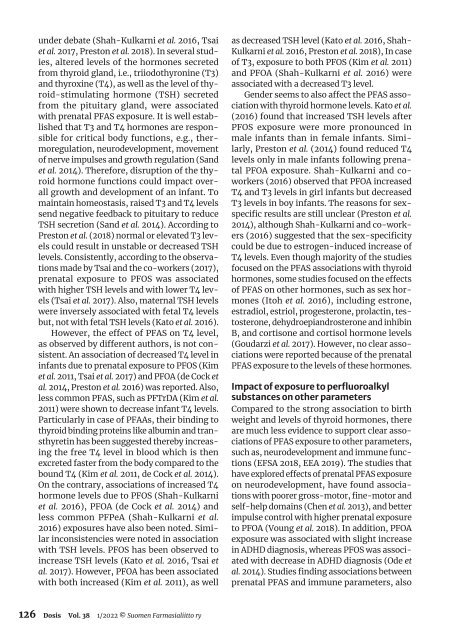DOSIS 1/2022
Farmaseuttinen aikakauskirja DOSIS 4/2021 vol.37 5uomen Farmasialiitto ry
Farmaseuttinen aikakauskirja DOSIS 4/2021 vol.37 5uomen Farmasialiitto ry
Create successful ePaper yourself
Turn your PDF publications into a flip-book with our unique Google optimized e-Paper software.
under debate (Shah-Kulkarni et al. 2016, Tsai<br />
et al. 2017, Preston et al. 2018). In several studies,<br />
altered levels of the hormones secreted<br />
from thyroid gland, i.e., triiodothyronine (T3)<br />
and thyroxine (T4), as well as the level of thyroid-stimulating<br />
hormone (TSH) secreted<br />
from the pituitary gland, were associated<br />
with prenatal PFAS exposure. It is well established<br />
that T3 and T4 hormones are responsible<br />
for critical body functions, e.g., thermoregulation,<br />
neurodevelopment, movement<br />
of nerve impulses and growth regulation (Sand<br />
et al. 2014). Therefore, disruption of the thyroid<br />
hormone functions could impact overall<br />
growth and development of an infant. To<br />
maintain homeostasis, raised T3 and T4 levels<br />
send negative feedback to pituitary to reduce<br />
TSH secretion (Sand et al. 2014). According to<br />
Preston et al. (2018) normal or elevated T3 levels<br />
could result in unstable or decreased TSH<br />
levels. Consistently, according to the observations<br />
made by Tsai and the co-workers (2017),<br />
prenatal exposure to PFOS was associated<br />
with higher TSH levels and with lower T4 levels<br />
(Tsai et al. 2017). Also, maternal TSH levels<br />
were inversely associated with fetal T4 levels<br />
but, not with fetal TSH levels (Kato et al. 2016).<br />
However, the effect of PFAS on T4 level,<br />
as observed by different authors, is not consistent.<br />
An association of decreased T4 level in<br />
infants due to prenatal exposure to PFOS (Kim<br />
et al. 2011, Tsai et al. 2017) and PFOA (de Cock et<br />
al. 2014, Preston et al. 2016) was reported. Also,<br />
less common PFAS, such as PFTrDA (Kim et al.<br />
2011) were shown to decrease infant T4 levels.<br />
Particularly in case of PFAAs, their binding to<br />
thyroid binding proteins like albumin and transthyretin<br />
has been suggested thereby increasing<br />
the free T4 level in blood which is then<br />
excreted faster from the body compared to the<br />
bound T4 (Kim et al. 2011, de Cock et al. 2014).<br />
On the contrary, associations of increased T4<br />
hormone levels due to PFOS (Shah-Kulkarni<br />
et al. 2016), PFOA (de Cock et al. 2014) and<br />
less common PFPeA (Shah-Kulkarni et al.<br />
2016) exposures have also been noted. Similar<br />
inconsistencies were noted in association<br />
with TSH levels. PFOS has been observed to<br />
increase TSH levels (Kato et al. 2016, Tsai et<br />
al. 2017). However, PFOA has been associated<br />
with both increased (Kim et al. 2011), as well<br />
as decreased TSH level (Kato et al. 2016, Shah-<br />
Kulkarni et al. 2016, Preston et al. 2018), In case<br />
of T3, exposure to both PFOS (Kim et al. 2011)<br />
and PFOA (Shah-Kulkarni et al. 2016) were<br />
associated with a decreased T3 level.<br />
Gender seems to also affect the PFAS association<br />
with thyroid hormone levels. Kato et al.<br />
(2016) found that increased TSH levels after<br />
PFOS exposure were more pronounced in<br />
male infants than in female infants. Similarly,<br />
Preston et al. (2014) found reduced T4<br />
levels only in male infants following prenatal<br />
PFOA exposure. Shah-Kulkarni and coworkers<br />
(2016) observed that PFOA increased<br />
T4 and T3 levels in girl infants but decreased<br />
T3 levels in boy infants. The reasons for sexspecific<br />
results are still unclear (Preston et al.<br />
2014), although Shah-Kulkarni and co-workers<br />
(2016) suggested that the sex-specificity<br />
could be due to estrogen-induced increase of<br />
T4 levels. Even though majority of the studies<br />
focused on the PFAS associations with thyroid<br />
hormones, some studies focused on the effects<br />
of PFAS on other hormones, such as sex hormones<br />
(Itoh et al. 2016), including estrone,<br />
estradiol, estriol, progesterone, prolactin, testosterone,<br />
dehydroepiandrosterone and inhibin<br />
B, and cortisone and cortisol hormone levels<br />
(Goudarzi et al. 2017). However, no clear associations<br />
were reported because of the prenatal<br />
PFAS exposure to the levels of these hormones.<br />
Impact of exposure to perfluoroalkyl<br />
substances on other parameters<br />
Compared to the strong association to birth<br />
weight and levels of thyroid hormones, there<br />
are much less evidence to support clear associations<br />
of PFAS exposure to other parameters,<br />
such as, neurodevelopment and immune functions<br />
(EFSA 2018, EEA 2019). The studies that<br />
have explored effects of prenatal PFAS exposure<br />
on neurodevelopment, have found associations<br />
with poorer gross-motor, fine-motor and<br />
self-help domains (Chen et al. 2013), and better<br />
impulse control with higher prenatal exposure<br />
to PFOA (Voung et al. 2018). In addition, PFOA<br />
exposure was associated with slight increase<br />
in ADHD diagnosis, whereas PFOS was associated<br />
with decrease in ADHD diagnosis (Ode et<br />
al. 2014). Studies finding associations between<br />
prenatal PFAS and immune parameters, also<br />
126 Dosis Vol. 38 1/<strong>2022</strong> © Suomen Farmasialiitto ry

















